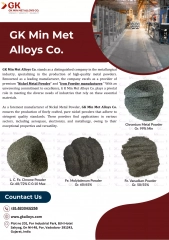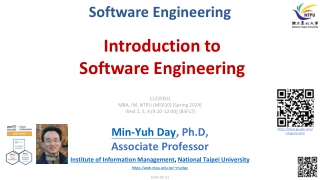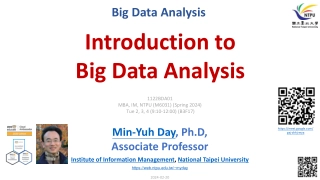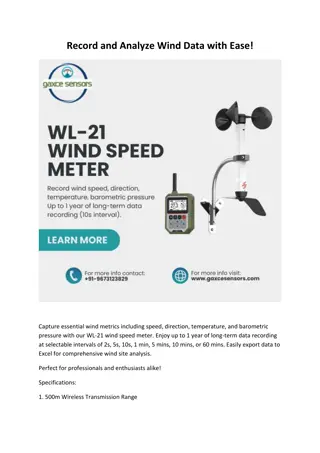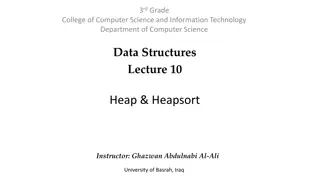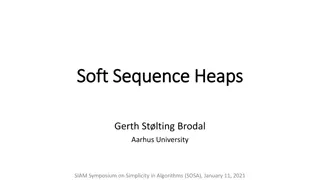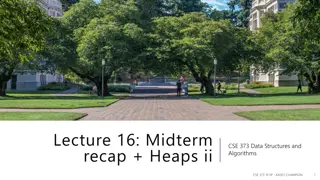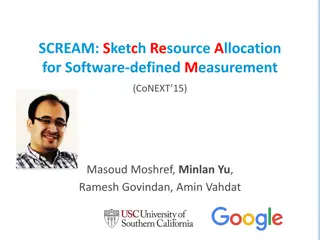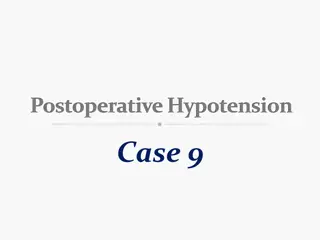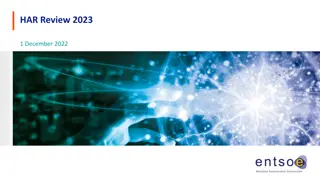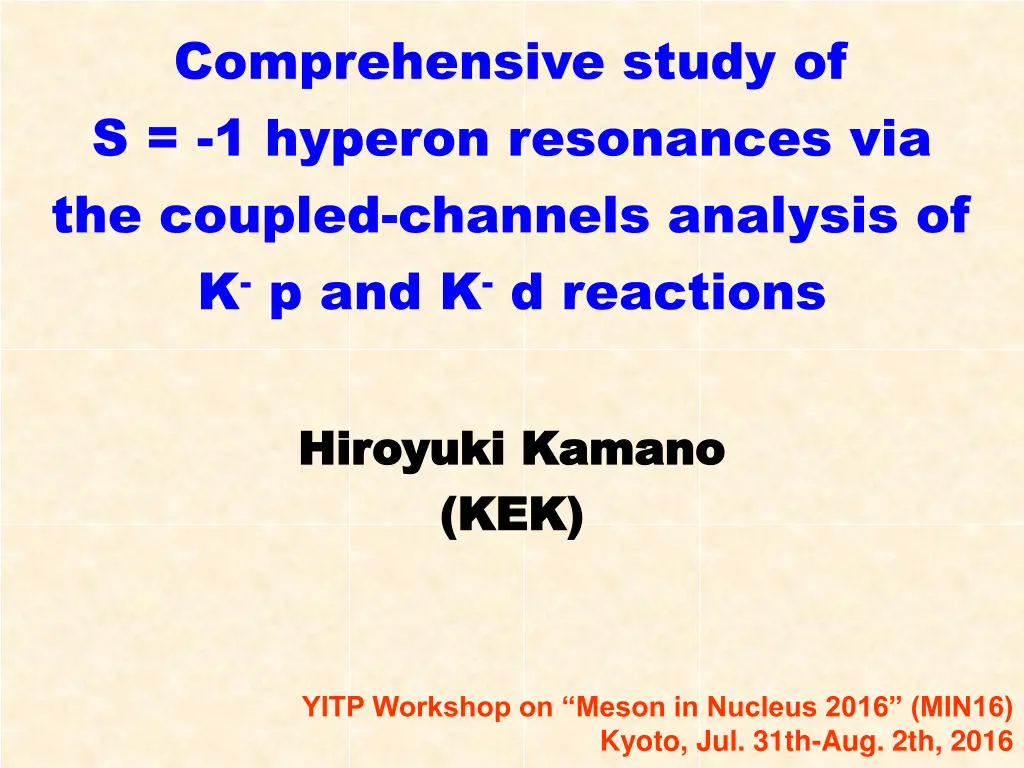
Hyperon Resonances Study via Coupled-Channels Analysis
Explore the in-depth analysis of S = -1 hyperon resonances through coupled-channels investigation of K-p and K-d reactions. Dive into the current understanding, challenges, and advancements in Y* spectroscopy using Dynamical Coupled-Channels (DCC) approach. Uncover the complexities of Y* resonances compared to N* & Λ*. Stay updated on the latest developments and research efforts in this fascinating field.
Download Presentation

Please find below an Image/Link to download the presentation.
The content on the website is provided AS IS for your information and personal use only. It may not be sold, licensed, or shared on other websites without obtaining consent from the author. If you encounter any issues during the download, it is possible that the publisher has removed the file from their server.
You are allowed to download the files provided on this website for personal or commercial use, subject to the condition that they are used lawfully. All files are the property of their respective owners.
The content on the website is provided AS IS for your information and personal use only. It may not be sold, licensed, or shared on other websites without obtaining consent from the author.
E N D
Presentation Transcript
Comprehensive study of S = -1 hyperon resonances via the coupled-channels analysis of K-p and K-d reactions Hiroyuki Kamano Hiroyuki Kamano (KEK) (KEK) YITP Workshop on Meson in Nucleus 2016 (MIN16) Kyoto, Jul. 31th-Aug. 2th, 2016
Outline Dynamical Coupled-Channels (DCC) analysis of K-p reactions and Y* (= *, *) spectroscopy HK, Nakamura, Lee, Sato, PRC90(2014)065204; 92(2015)025205 Study of K-d low-lying Y* resonances YN reactions to establish HK, Lee, in preparation
Dynamical Coupled-Channels (DCC) analysis of K-p reactions and Y* spectroscopy (1 of 2)
Current situation of Y*(= *, *) spectroscopy Y* (= *, *) resonances are much less understood than N* & * !! * * Most of *s are poorly established. ONLY 6 out of 26 reported *s are rated as 4* by PDG Even low-lying states are still uncertain. Spin-parity has not been determined for a number of Y* resonances. Before 2012, PDG listed only Breit-Wigner (BW) mass and width [except (1385)3/2+, (1520)3/2-] N* & * case: Resonances defined by poles of scattering amplitudes are extensively studied; PDG lists BOTH pole and BW parameters. PDG listing
Current situation of Y*(= *, *) spectroscopy Y* (= *, *) resonances are much less understood than N* & * !! * * Comprehensive partial-wave analyses of K-p reactions to extract Y* defined by poles have been accomplished just recently just recently : Kent State University (KSU) group ( 2013, KSU on-shell parametrization of S-matrix) Zhang et al., PRC88(2013)035204, 035205. Reanalysis of KSU single-energy solution using an on-shell K-matrix model (Femandez-Ramirez et al., arXiv:1510.07065) Our group ( 2014-2015, dynamical coupled-channels approach) HK, Nakamura, Lee, Sato, PRC90(2014)065204; 92(2015)025205 PDG listing
Dynamical Coupled-Channels (DCC) approach to * & * productions Dynamical Coupled-Channels (DCC) model: [Matsuyama, Sato, Lee, PR439(2007)193; HK, Nakamura, Lee, Sato, PRC88(2013)035209;90(2014)065204] off-shell effect CC effect quasi two-body channels of three-body & KN Summing up all possible transitions between reaction channels !! ( satisfies multichannel two- and three-body unitarity) e.g. KN scattering K K K V N N * Momentum integral takes into account off-shell rescattering effects in the intermediate processes.
What we have done so far With the DCC approach developed for the S= -1 sector, we made: Supercomputers are necessary for the analysis !! Comprehensive analysis of ALL available data (more than 17,000 data points) of K-p KN, , , , K up to W = 2.1 GeV. [HK, Nakamura, Lee, Sato, PRC90(2014)065204] Determination of threshold parameters (scattering lengths, effective ranges, ); the partial-wave amplitudes of KN KN, , , , K for S, P, D, and F waves. [HK, Nakamura, Lee, Sato, PRC90(2014)065204] Extraction of Y* resonance parameters (mass, width, couplings, ) defined by poles of scattering amplitudes. [HK, Nakamura, Lee, Sato, PRC92(2015)025205]
Results of the fits K-p MB total cross sections HK, Nakamura, Lee, Sato, PRC90(2014)065204 Red: Model A Blue: Model B Incompleteness of the current database allows us to have two parameter sets that give similar quality of the fit.
Results of the fits K-p K-p scattering HK, Nakamura, Lee, Sato, PRC90(2014)065204 d /d (1464 < W < 1831 MeV) d /d (1832 < W < 2100 MeV) P (1730 < W < 2080 MeV) Red: Model A Blue: Model B
Extracted * and * mass spectrum HK, Nakamura, Lee, Sato, PRC92(2015)025205 Spectrum for Y* resonances found above the KN threshold (+ updates) Red: Model A Blue: Model B Green: KSU[PRC88(2013)035205] Black: PDG (only 4- & 3-star Y*; Breit-Wigner) -2Im(MR) ( width ) MR: Resonance pole mass (complex) Re(MR) New narrow 3/2+resonance M = 1671 5i MeV near the threshold !! resonance (I=0) JP(LI 2J) JP(LI 2J) resonance (I=1) KN threshold
Extracted * and * mass spectrum HK, Nakamura, Lee, Sato, PRC92(2015)025205 Spectrum for Y* resonances found above the KN threshold (+ updates) Red: Model A Blue: Model B Green: KSU[PRC88(2013)035205] Black: PDG (only 4- & 3-star Y*; Breit-Wigner) -2Im(MR) ( width ) MR: Resonance pole mass (complex) Re(MR) New narrow 3/2+resonance M = 1671 5i MeV near the threshold !! resonance (I=0) JP(LI 2J) JP(LI 2J) resonance (I=1) d /d of K-p Model A Model B P03 off New narrow P03 resonance found in Model B is responsible for the angular dependence of d /d !! KN threshold
Extracted * and * mass spectrum HK, Nakamura, Lee, Sato, PRC92(2015)025205 Spectrum for Y* resonances found above the KN threshold (+ updates) Red: Model A Blue: Model B Green: KSU[PRC88(2013)035205] Black: PDG (only 4- & 3-star Y*; Breit-Wigner) -2Im(MR) ( width ) MR: Resonance pole mass (complex) Re(MR) New narrow 3/2+resonance M = 1671 5i MeV near the threshold !! resonance (I=0) JP(LI 2J) JP(LI 2J) resonance (I=1) KN threshold Low-lying * resonances (PDG) ? Spin partner of (1520)3/2-??
Study of K-d YN reactions to establish low-lying Y* resonances (2 of 2)
Strategy for establishing Y* resonances using antikaon-induced reactions KN new spin partner of (1520) ?? poorly established (one- & two-star) * resonances high-mass Y* resonances new narrow 3/2+ * ?? (1405) s1/2 Kd YN KN, Y, Y, K , Y, Y, Complete experiments for K-p K N KN KN K d K *, * Y N (e.g, J-PARC E31) Application of our DCC approach to Kd reactions is underway (HK & Lee), aiming at COMBINED analysis of KN and Kd reactions !!! , KN, 2 3 reactions: K-p New measurements at J-PARC ??
Model for deuteron-target reactions Multistep processes are treated perturbatively . Off-shell amplitudes for meson-baryon sub-processes ( ) are taken from our dynamical coupled-channels model. HK, Nakamura, Lee, Sato, PRC90(2014)065203 YN rescattering term K-exchange term Impulse term K K K N N N + ... + + d d d K Y Y Y Use, e.g., deuteron w.f. from ANL-V18 potential [PRC51(1995)38] Use YN potential, e.g., in PRC40(1989)2226; PRC59(1999)21; PRC59(1999)3009 Completely dominates the reaction processes at the kinematics with N~ 0. ( J-PARC E31) Unique feature of our work: For elementary meson-baryon subprocesses, we employ amplitudes that are well-tested by K-p KN, , , , K up to W = 2.1 GeV. not only for S wave, but also P, D, F waves.
Summary KN, , , , K Accomplished comprehensive analysis of K-p up to W = 2.1 GeV for the first time within a dynamical coupled-channels approach. Successfully extracted partial-wave amplitudes (up to F wave) and Y* resonance parameters defined by poles of amplitudes. New narrow JP= 3/2+ * resonance (MR= 1672-i5 MeV) located near the threshold New JP= 1/2- * resonance (Re MR~ 1520 MeV) with mass close to (1520)3/2- Unestablished low-lying * resonances just above KN threshold
Summary KN, , , , K Accomplished comprehensive analysis of K-p up to W = 2.1 GeV for the first time within a dynamical coupled-channels approach. Successfully extracted partial-wave amplitudes (up to F wave) and Y* resonance parameters defined by poles of amplitudes. New narrow JP= 3/2+ * resonance (MR= 1672-i5 MeV) located near the threshold New JP= 1/2- * resonance (Re MR~ 1520 MeV) with mass close to (1520)3/2- Unestablished low-lying * resonances just above KN threshold New accurate data for both KN and Kd reactions are much appreciated !!! Complete experiments for 2 2 reaction ( KN KN, , , , K , , Y, Y, Y, ) 3 reaction ( KN Y, KN, ) to determine high-mass Y* 2 Deuteron-target reaction ( Kd YN, ) to determine low-lying Y*
Summary KN, , , , K Accomplished comprehensive analysis of K-p up to W = 2.1 GeV for the first time within a dynamical coupled-channels approach. Successfully extracted partial-wave amplitudes (up to F wave) and Y* resonance parameters defined by poles of amplitudes. New narrow JP= 3/2+ * resonance (MR= 1672-i5 MeV) located near the threshold New JP= 1/2- * resonance (Re MR~ 1520 MeV) with mass close to (1520)3/2- Unestablished low-lying * resonances just above KN threshold New accurate data for both KN and Kd reactions are much appreciated !!! Complete experiments for 2 2 reaction ( KN KN, , , , K , , Y, Y, Y, ) 3 reaction ( KN Y, KN, ) to determine high-mass Y* 2 Deuteron-target reaction ( Kd YN, ) to determine low-lying Y* The help of J-PARC is definitely needed for complete determination of Y* resonance mass spectrum !!!
Importance of 2 3 reactions: Branching ratios of high-mass Y* resonances High-mass Y* have large branching ratio to * ( ) & K*N ( KN) , KN, data would play a crucial role for establishing high-mass Y*. K-p Similar to high-mass N* and * case, where N channel plays a crucial role. (e.g., measurement of N N reactions at J-PARC E45) Model A Model B HK, Nakamura, Lee, Sato, PRC92(2015)025205
Extracted scattering lengths and effective ranges HK, Nakamura, Lee, Sato, PRC90(2014)065204 Scattering length and effective range aK-p= -0.65 + i0.74 fm (Model A) aK-p= -0.65 + i0.76 fm (Model B)
S-wave dominance ?? K-p MB total cross sections near threshold Model B Solid: Full Dashed: S wave only For K- p higher partial waves visibly contribute to the cross sections even in the threshold region. consistent with the observation in Jackson et al., PRC91(2015)065208 , , K , Na ve expectation for S-wave dominance near the threshold sometimes does not hold !! HK, Nakamura, Lee, Sato, PRC90(2014)065204
Kinematical (W, cos) coverage of available K K- -p p K KN, , , N, , , , K , K data data available low statistics data d /d P Pd /d conflicting data
Kinematical (W, cos) coverage of available K K- -p p K KN, , , N, , , , K , K data Predicted spin-rotation angle Red: Model A Blue: Model B Black: KSU The KSU results are computed by us using their amplitudes in PRC88(2013)035204. ## NOTE: is modulo 2 data available low statistics data d /d P Pd /d conflicting data
Importance of 2 3 reactions: Dominance of cross sections at high W TCS for K-p X KN, , , , K Sum of K-p (Computed with Model A) Almost come from 2 3 reactions !! TCS for 2 (K-p , KN, ): significant above W ~ 1.7 GeV. even larger than the 2 above W ~ 1.9 GeV !! 3 reactions 2 TCS Effects of 3-body channels on Y* resonance parameters are expected to be sizable. However, at present essentially no differential cross section data are available for 2 that can be used for detailed partial wave analyses !! 3 reactions

